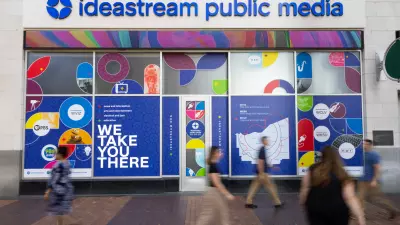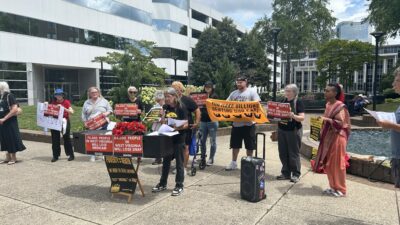For those who work in Ohio’s public media space, coverage can depend on where they live and work. For those in rural counties, for instance, that means being the only news source in the area.

But for some, like The Ohio Newsroom, the mandate is statewide. Reporters use their resources to make sure Ohioans know their neighbors, along with the residents of far-off towns they may not know.
“To me, it’s really important that people in Columbus hear about what’s going on in Bucyrus, or that people in Cleveland hear what’s happening in Findlay,” said Clare Roth, managing editor of The Ohio Newsroom. “We’re all connected, we’re all members of this state … and I think that’s an essential service that public radio does very well.”
The Ohio Newsroom started three years ago with help from a Corporation for Public Broadcasting grant. For Roth, as well as other journalists in the state, the coverage that they do means allowing Ohioans to be able to hear themselves in the news.
“That representation matters and means something, for people to hear folks from their area on the radio and to hear stories about the places that they’re from,” Roth said.
Public media workers in Ohio are worried about an ongoing effort to claw back federal funds, including more than $1 billion for Corporation for Public Broadcasting. Funding from the CPB goes to local stations who distribute NPR and PBS, and provides grant funding for projects and local programming.
The U.S. House already approved what’s called a rescissions bill, which Republican leadership and the Trump administration has said is cost-cutting measure, this time for about $9 billion in reductions to foreign aid, along with public media on the homefront. It’s now in the hands of the U.S. Senate, facing a July 18 deadline.
Repercussions
Many public media outlets in Ohio have enlisted the help of their supporters, listeners, and readers to reach out to their federal representatives and senators and urge push back against the bill.
“I just really believe that public media needs to belong to the public and should be accountable to the public,” said Kevin Martin, president and CEO of Ideastream Public Media.
The station actually contains many stations, including the WKSU for NPR and local coverage, PBS station WVIZ. From left, Kendall Crawford, Clare Roth and Erin Gottsacker, of The Ohio Newsroom.
(Photo courtesy of The Ohio Newsroom)
Ideastream is also helps provides livestreams of legislative sessions, committee meetings, press conferences and even the Ohio Supreme Court’s oral arguments through The Ohio Channel.
Martin has memories of similar attempts to cut federal public media funding, having worked as a distributor of community service grants for the CPB himself.
“I can not remember a Republican president that hasn’t had public media zeroed out in their budget,” Martin said.
But the bipartisan support for public media has always won the day. With the new administration, however, Martin and other Ohio public media leaders are seeing a different environment.
“Every member of Congress, when they vote, it’s a calculation, and I would say nowadays it’s about the repercussions of their vote,” Martin said.
Local media could see its own repercussions with the budget cuts as they stand, cuts that could not only impact the amount of content the stations can produce, but also their ability to provide things like emergency alerts.
“There’s a very well-established infrastructure for emergency alerts that are made possible through public media,” said Luke Dennis, general manager of WYSO in Yellow Springs. “Public media is, in many places, the only media, so when the internet doesn’t work, or you can’t afford it at all, it matters to be able to have that service.”
WYSO recently established itself as an independent news station apart from Antioch College, and they’re working to grow on their own. The station was able to raise about $3.5 million in about nine months “because the community got excited about WYSO being independent,” according to Dennis.
But the CPB cuts could mean a loss of about $300,000 for WYSO.
“It will force us to quickly adapt and approve the plan b budget that we have in our back pocket, and we don’t want to do that because we’re already working lean and mean,” Dennis said.
The message from public media leaders to listeners and to lawmakers is unified: the work they do serves their hyper-local community, and national services like PBS make a difference.
“I often ask people if they grew up watching Sesame Street or Mr. Rogers’ Neighborhood, because that reminds us that education is a core tenet of public media,” Dennis said.
Dennis and Martin said supporters are sending emails and making phone calls by the thousands in support of public media.
Martin said Ideastream would “probably need some consolidation” if the cuts are made, but he and Roth both see the problem at a higher level than station-to-station cuts.
“I worry about the system as a whole,” Roth said. “I know what a difference it can make to tell stories and to really get to the richness of Ohio life, and I hate to think of that being curtailed anywhere.”
Ohio’s congressional delegation
All of Ohio’s U.S. House Democrats voted against the cuts, with the exception of Rep. Joyce Beatty, who was absent from the vote for medical reasons.
Beatty told the Capital Journal in a statement that she strongly opposes the legislation and urged her colleagues “to keep public radio and public broadcast well-funded, free and accessible.”
Only one of Ohio’s Republican House members, Rep. Mike Turner, voted against the rescissions bill.
Turner did not respond to the Capital Journal’s request for comment, but Democratic representatives were universal in their support for public media in Ohio, particularly it’s ability to give access to rural and low-income areas.
“For families who can’t afford access to paid cable or streaming options, easy access to unbiased local media that keeps them well-informed is a vital lifeline that is helping to educate future generations,” according to Rep. Marcy Kaptur.
Kaptur also said “cancelling Elmo won’t fix the cost-of-living crisis,” and Rep. Shontel Brown said the bill isn’t about saving money, as Republican leaders claim. A protester holds a sign in support of funding for public media during a May 1, 2025, rally at the Kansas Statehouse in Topeka as part of a 50501 national day of action. (Photo by Sherman Smith/Kansas Reflector)
“Public broadcasting is a tiny sliver of the federal budget, and for decades, the American people have received a terrific return on this investment,” Brown said in a statement. “The fact is, if we don’t invest in educational programming for children, there is no guarantee that the commercial media will.”
Rep. Emilia Sykes said the proposed cuts “would have a massively negative impact” on her district, and cutting the funding to local stations “will be a disservice to our communities, as well as those across the country that aren’t part of bigger media markets.”
Lawmakers who responded to questions about their votes on the bill emphasized the public interest the threat to public media funding has garnered.
“We’ve gotten calls from so many constituents who say this is a really big deal to them,” said Rep. Greg Landsman, in a statement. “Cutting over a billion dollars would hit small communities, and we know these are good programs that serve real people.”
GOP Rep. Warren Davidson declined to comment for the story, but posted screenshots of NPR headlines on racism and gender inequality, along with a PBS headline on implicit bias and a headline from an unnamed media source mentioning NPR’s use of audio from an abortion in a news report to his official X account on June 12.
“This type of ‘coverage’ shouldn’t get a cent of taxpayer dollars,” Davidson’s post read. “Defund NPR and PBS.”
The Capital Journal did not receive responses from the other Ohio members who voted to approve the cuts: U.S. Reps. David Taylor, Troy Balderson, Bob Latta, Jim Jordan, David Joyce, Mike Carey and Max Miller.
In a video posted to his official X account, Miller spoke proudly of the cuts, though he didn’t specifically mention the CPB funds. He said the rescissions bill reductions “root out waste, fraud and abuse of taxpayer dollars.”
“These are codifying (Department of Government Efficiency) cuts that don’t advance American interests,” Miller said.
The U.S. Senate has until mid-July to vote on the measure, or the rescissions bill will expire, and the funding will be sent to the entities as previously planned.
A spokesperson for Ohio Republican U.S. Sen. Bernie Moreno said the congressman already plans to vote for the cuts.
“It is a blatant waste of American taxpayer dollars that Senator Moreno looks forward to putting an end to immediately,” said spokesperson Reagan McCarthy.
Republican U.S. Sen. Jon Husted did not respond to request for comment.







